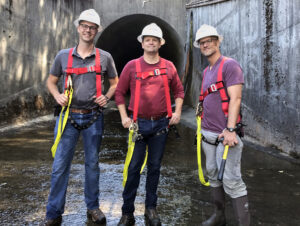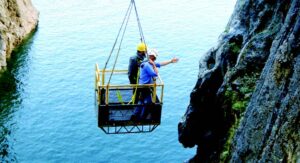In December 2021, the Federal Energy Regulatory Commission (FERC) released a final rule amending its regulations on the safety of water power projects and project works, contained in title 18, part 12, of the Code of Federal Regulations. The new regulations introduce two tiers of public safety inspections, codify existing guidance on Owners Dam Safety Programs, and update regulations related to public safety incident reporting. At the same time, FERC released four new draft chapters to its Engineering Guidelines for the Evaluation of Hydropower Projects. Chapter 15 concerns supporting technical information documents, chapter 16 covers the Part 12D program, chapter 17 covers potential failure mode analysis (PFMA), and chapter 18 covers risk analysis. In this interview, Tom Fitzgerald, the western regional manager for dam engineering at Schnabel Engineering, tells Hydro Leader about what the new requirements mean for dam owners and operators.
Hydro Leader: Please tell us about your background and how you came to be in your current position at Schnabel.
Tom Fitzgerald: I’ve been working on dam rehabilitation and design since I graduated college in the mid-1990s. For the last 10–15 years, I have focused on rehabilitation, evaluation, Part 12 inspections, and risk assessments for hydropower dams. Schnabel started as an East Coast firm, but we have expanded in recent years into the western United States. I now manage our dam unit’s business operations in the western region, supporting offices in Seattle; Boise; Denver; and Longmont, Colorado.
Hydro Leader: Please tell us about Schnabel Engineering.
Tom Fitzgerald: Schnabel Engineering started out primarily as a geotechnical engineering firm in the mid-Atlantic. As we continued to grow, we moved into other markets. In the mid‑1990s, we started our dam engineering practice. That evolved over the years, and it now accounts for more than half our revenue each year. We still have a strong geotechnical engineering practice focused on transportation and serving federal and energy clients. The third business line is tunnel design. In short, our focus is on geotechnical engineering, dam engineering, and tunnels.
Hydro Leader: Please elaborate on your dam safety work.
Tom Fitzgerald: We work on all types of dams, but most of my focus has been on hydropower dams. FERC has strict requirements for having an independent consultant (IC) perform reviews of licensed hydropower projects every 5 years. That process is generally referred to as a Part 12D inspection. The IC who leads that inspection needs to meet minimum qualifications and be approved by FERC’s Division of Dam Safety and Inspections (D2SI). I lead a few of those inspections every year as the IC. We also do quite a few studies, analyses, and investigations to make sure that dams meet current criteria. In cases in which the dams do not meet the criteria, we have been involved with the analysis, design, and oversight of construction for various rehabilitation projects. Typical projects include the stabilization of dams, the expansion of spillway capacity, and the refurbishment or replacement of aging equipment.
Hydro Leader: What does it take to be approved by FERC as an IC?
Tom Fitzgerald: It requires a minimum of 10 years of experience working on dams. Not only does FERC want you to have 10 years of experience, but it wants to make sure your experience is applicable to the structure you will be inspecting. For example, if you’re primarily a geotechnical engineer, I don’t think FERC would approve you as the IC for a concrete arch dam, because that’s not your area of expertise.

Hydro Leader: Please tell us about FERC’s recent regulatory changes and how they relate to the field of risk-informed decisionmaking (RIDM).
Tom Fitzgerald: FERC just released a final rule amending its regulations as well as four new draft chapters for its Engineering Guidelines. Previously, dam operators were required to do a Part 12D inspection every 5 years. The rules for these inspections had not been updated since the early 1980s. A lot has changed since then. The new rules codify updates, incorporating several changes to the requirements. One of the most significant changes is that FERC now requires two different types of inspections—a comprehensive assessment and a periodic assessment— which are to be conducted alternately every 5 years. The new guidelines essentially call for a comprehensive assessment every 10 years and a periodic assessment every 10 years.
The comprehensive assessment is more detailed and requires a higher level of effort than what was previously prescribed by the Part 12 requirements. It also requires a larger team, including an IC and subject-matter experts for applicable technical disciplines, such as hydrology and hydraulics; geotechnical, geologic, and structural disciplines; and so on. The periodic assessment is intended to be less intensive.
As part of the comprehensive assessment, FERC is requiring a semiquantitative risk assessment, which is new. Risk assessments were not previously required by FERC, but it started rolling out guidelines for RIDM about 5 years ago. Since then, several owners have seen value in the process and have signed up for pilot studies using the RIDM processes. These workshops typically involve FERC representatives, a risk facilitator, dam safety personnel, operations personnel, and subject-matter experts to provide technical input. FERC has defined four levels of risk analysis, from screening (level 1) all the way up to quantitative risk analysis (level 4).
Hydro Leader: How does that differ from the risk assessments that dam owners and operators were previously required to do?
Tom Fitzgerald: Previously, FERC did not require risk assessments. Some owners have opted to do them as part of the pilot studies, but these were voluntary prior to the new rules. Other federal agencies, such as the Bureau of Reclamation and the U.S. Army Corps of Engineers, have well-developed guidelines and processes for assessing risk at their dams. FERC has borrowed many of the concepts and technical information from these other agencies, but because FERC regulates dams owned by others, it has to approach risk a little bit differently.
Hydro Leader: What changes have been made when it comes to PFMA?
Tom Fitzgerald: Previously, potential failure modes (PFMs) were classified, per the FERC guidelines, into one of four categories. Category 1 was used for highlighted failure modes. These are the PFMs that have the highest significance considering their probability of occurrence or consequence. Category 2 covered failure modes that were credible but not highlighted. Category 3 covered failure modes for which there was not enough information an

d that required analysis to determine whether they were possible or not. Category 4 covered failure modes that were ruled out or not plausible. These category designations were often assigned in confused or inconsistent ways.
The new guidelines provide a new screening process to rule out PFMs that are not physically possible and to evaluate the disposition of credible PFMs. Performing a semiquantitative risk assessment will help to evaluate the PFMs for a project and provide a consistent way to identify the PFMs that are driving risk. This will help owners to prioritize surveillance and monitoring and to implement risk reduction measures that provide the most value.
Hydro Leader: Would you tell us about the new draft chapter 15, which revises requirements for supporting technical information documents?
Tom Fitzgerald: FERC has now provided detailed, specific requirements for every part of those documents, including how your analysis should be presented, what level of detail is necessary, and how things should be documented and organized. Based on my review of a lot of projects over the years, I think that getting up to speed on this requirement and complying with it is going to require considerable effort from most owners.
Hydro Leader: It sounds like each of these new changes most likely implies some extra work for dam owners and operators.
Tom Fitzgerald: That is a fair assessment.
Hydro Leader: Is there anything that might ease the load— for example, the introduction of less-comprehensive periodic inspections on an alternating 10‑year cycle?
Tom Fitzgerald: That was the intent of FERC. It realized that it was asking for a bigger evaluation during the comprehensive cycle, so it wanted to lessen the requirements for the alternating cycle. However, I believe that most owners will see that the new rules and guidelines are going to increase the overall level of effort considerably, at least over the next two cycles.
Hydro Leader: To what extent were these changes inspired by dam safety incidents like the Oroville spillway incident in California or the Edenville and Sanford Dam failures in Michigan?
Tom Fitzgerald: These changes were already in motion before the Michigan dam failures occurred. A couple of precipitating events over the past few decades inspired the new policies and procedures at FERC D2SI. For example, the 2005 failure of Taum Sauk Dam prompted FERC to begin requiring every licensee to prepare an Owners Dam Safety Program document to underscore the importance of having a formalized dam safety program. After the Oroville spillway incident, there was a lot of scrutiny on the dam safety community, and I am proud to say that as an industry we take the lessons learned from these types of incidents very seriously. An independent forensic team evaluated the incident at Oroville and an after-action panel was assembled specifically to evaluate FERC’s dam safety program. The U.S. Government Accountability Office also performed a review of FERC’s dam safety program and provided recommendations.
Hydro Leader: What do you think the next steps dam owners and operators should take in response to these changes?
Tom Fitzgerald: From what I understand, there is going to be a 90‑day implementation period. FERC also realizes that it’s going to take time for owners, consultants, and FERC staff to absorb these new rules and guidelines. That’s not going to happen overnight. One of the biggest challenges that we have as an industry is that risk assessment is relatively new, and we don’t have a lot of facilitators and subject-matter experts with risk experience. I’m not sure if there are enough trained individuals to handle all these risk assessments in a way that’s meaningful and consistent. As an industry, we are all going to have to learn and adapt. I believe that these risk assessments will develop over the next cycle or two before they are consistently conducted at a high level. One of the challenges is providing adequate training so that these can be done well.
Hydro Leader: Is there anything you would like to add?
Tom Fitzgerald: Change is always difficult, but for the safety of our projects, these new rules and guidelines are going to be beneficial.
Tom Fitzgerald is the western regional manager for dam engineering at Schnabel Engineering. For more on Schnabel Engineering, visit www.schnabel-eng.com.


